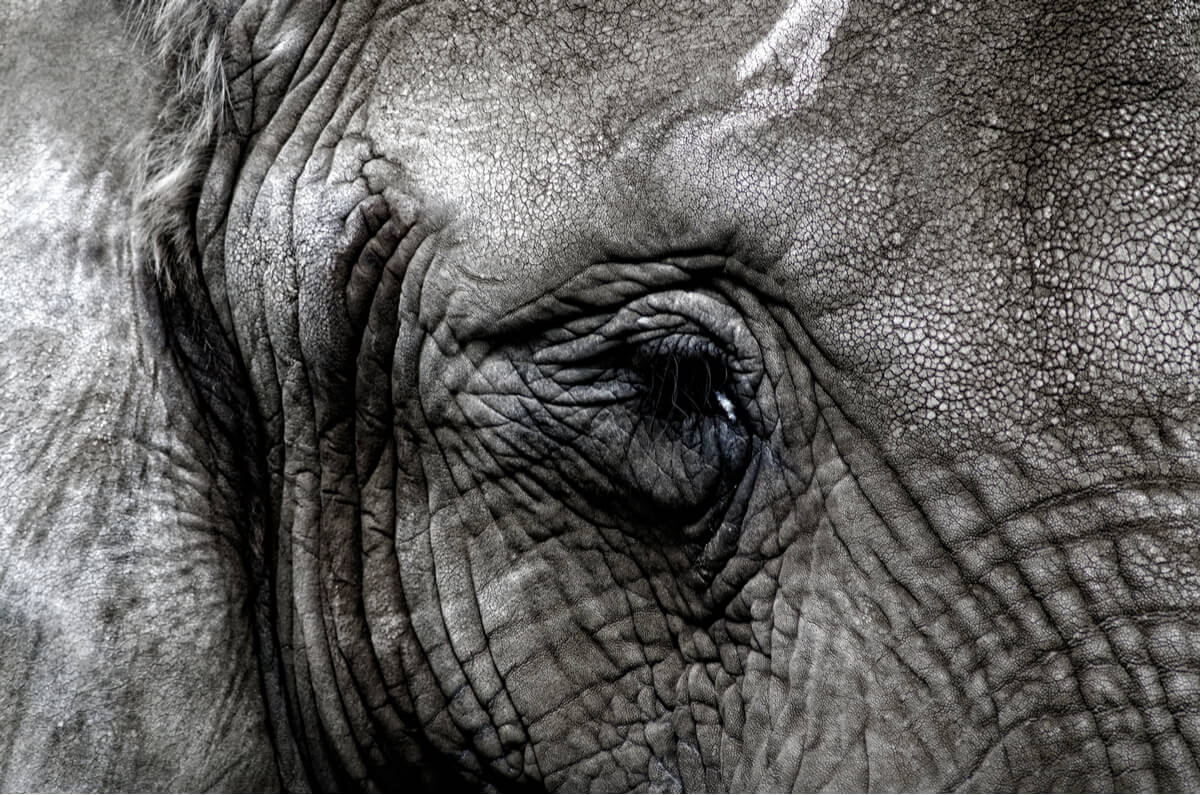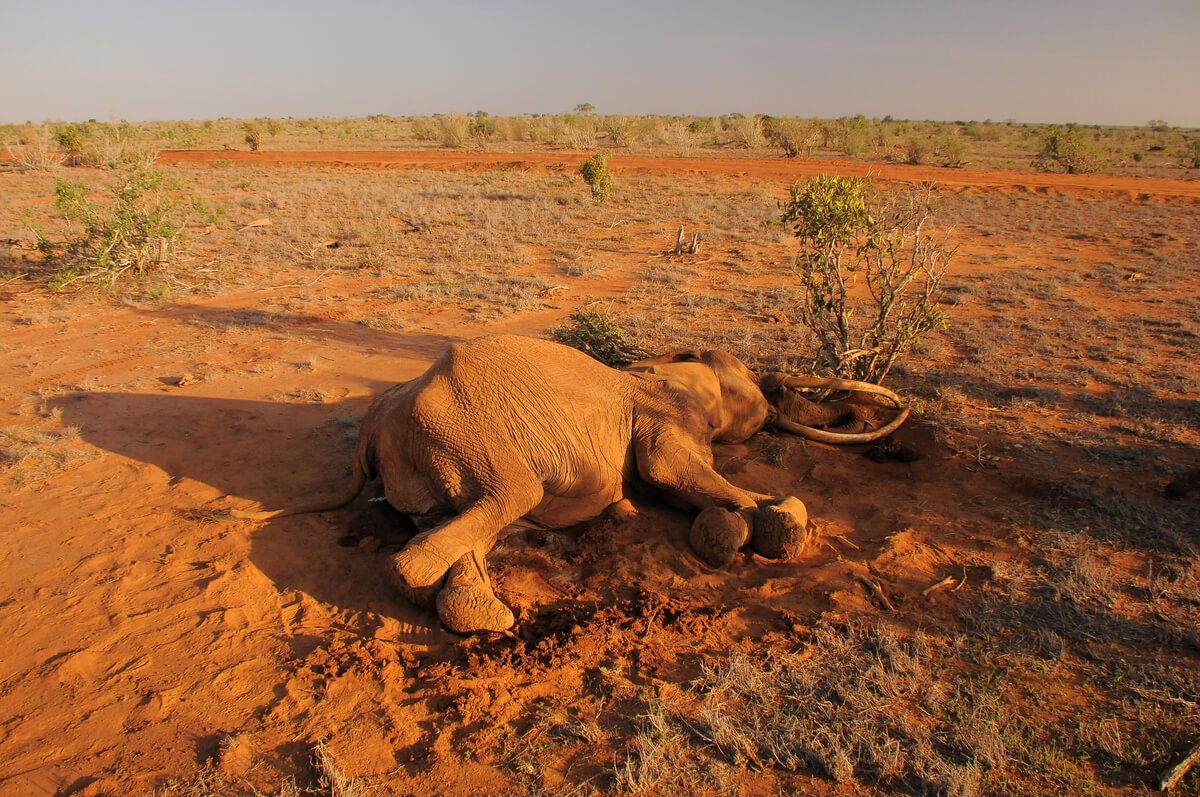Why Do Some Elephants Have Tusks and Others Don't?

Elephants are the largest land mammals on the planet. These animals can live up to 70 years and some species weigh 6,000 kilos (13200 lbs). However, it has been recorded that some elephants have tusks and others don’t, as these pieces carry a great poaching history behind them.
The explanation that some experts give to the question of why some elephants have tusks and others don’t – especially females – is human greed and poaching, as their ivory tusks attract illegal hunters, which has had many consequences for the species.
Why do some elephants have tusks and others don’t?
In the Gorongosa National Park, in Mozambique, a country located in southern Africa, there are several old elephants that bear the marks of the civil war that this country lived through for 15 years, between 1977 and 1992. This is why many of them they don’t have tusks.
AnimaNaturali says that this conflict killed around 90% of the elephants, slaughtered for the ivory of their tusks and for their meat. This matter was the main source of funding in the conflict and, after the war, fewer than 100 elephants were left alive in the area.
Organizations like Elephant Voices studied the few survivors of this war, the majority of whom were female without tusks. Thanks to a mutation in the gene that gives rise to these ivory structures, these females were able to survive, say WWF experts.
Because the mutation is heritable, their young are born predisposed not to develop tusks. This isn’t an adaptation that responds to the threat of humans per se, but it does favor the elephants that are born without tusks, as those that do have them continue to be illegally hunted for their ivory in the rest of the world.

The same story, but in other places
Mozambique isn’t the only place where the absence of tusks is present in elephants. There are also other countries with a great hunting history behind them. In South Africa, for example, 98% of the 174 females in the Addo Elephant National Park didn’t develop tusks from the start of the 21st century.
Another place where you can see this is in Ruaha National Park in southern Tanzania, an area looted by poachers in the 1970s and 1980s. There, 21% of females older than 5 years don’t have tusks.
As in Gorgosa, in Ruaha the percentages are higher among older females. About 35% of females over the age of 25 don’t have tusks and, among elephants aged 5 to 25 years, 13% of females don’t.
The lack of tusks occurs disproportionately among females, as tuskless males are extremely rare in African elephants. Elephant behavior expert Joyce Poole says she has only seen three or four tuskless males in her entire life.
Regardless of male or female elephants, humans are leaving a mark on the largest land mammals on Earth. As if that weren’t enough, areas of Asia that have seen ivory hunts – like Africa – have very high levels of tuskless elephants.
Some elephants have tusks, but smaller ones
In southern Kenya, illegal hunting has reduced tusk sizes in elephants, as well as elsewhere. The tusks observed between 2005 and 2013 have been found to be smaller than those of elephants slaughtered between 1966 and 1968. Their size was reduced by around a fifth in males and more than a third in females.
And why do elephants have tusks?
Elephants typically have tusks because they permit them to do most of their daily tasks, such as digging for water or minerals, removing bark from the tress for fiber intake, helping males compete for females, defending themselves, lifting and moving objects, and protecting their trunk.
Elephants’ tusks are teeth that extend beyond their mouths. They’re connected to the skull and have nerve endings, just like human teeth. If the tusk is broken, removed, or damaged, it doesn’t grow back.
However, despite losing their tusks, elephants can still survive and appear to be healthy. However, experts believe that this handicap may be influencing elephant behavior and how their communities function. In addition, the work they do with their tusks is vital for other species, and so their absence also has implications for the ecosystem that surrounds them.
The trees that elephants knock down or the holes that they dig for water are very important to species that depend on these actions. As you can see, their tusks aren’t only useful to them, but they also help to create habitats.
For example, certain lizards prefer to make their homes in trees knocked down by elephants.
The ivory trade
The ivory trade is a business – mostly illegal – for the ivory tusks of some species such as the common hippopotamus (Hippopotamus amphibius), the walrus (Odobenus rosmarus ), the narwhal (Monodon monoceros), the African or savanna elephant (Loxodonta spp.) and the Asian elephant (Elephas maximus).
Ivory has been commercialized for many years in regions such as Greenland, Alaska and Siberia and has led to endangering the species that possess ivory, say studies from the Autonomous University of Barcelona.
In this case, elephant ivory has been exported from Africa and Asia for centuries, as there are records from the fourteenth century BC During the colonization of Africa, this material was exported to make piano keys, billiard balls, jewelry and other objects of exotic wealth, but of a tortuous and bloody origin.
In 1979, there were approximately 1.3 million elephants in Africa, but in 1989 there were only 600,000. All of this was the result of the international ivory trade. In this decade, about 75,000 elephants were killed a year, worth about $ 1 billion.
A current problem
Most elephants have tusks and all those that do, both female and male, are targeted for illegal hunting. This harms their populations, as they are left practically without any males to breed with, because the most coveted tusks are those of the older males, because they’re heavier.
In addition, elephant society depends on the females, and hunters kill entire herds of them, orphaning the young, which die without actually reproducing. This is another consequence that threatens the species.
Hunting for the ivory trade remains the greatest threat to tusked elephants. The loss of habitat and the conflict that is created between humans and elephants is another of the threats that these animals suffer.
According to WWF, approximately 100 African elephants die daily for their ivory tusks, meat and other parts of their body. Today there are 110,000 fewer elephants in Africa than in the past decade, when there were around 415,000.

Because of this, in Africa, there are protected areas established to conserve elephants. In several places – such as Mozambique – work is being done to reduce the conflicts that exist between humans and these pachyderms, to end poaching and other damage to species.
All cited sources were thoroughly reviewed by our team to ensure their quality, reliability, currency, and validity. The bibliography of this article was considered reliable and of academic or scientific accuracy.
AnimaNaturalis. (s. f.). Bajo la presión de la caza furtiva, los elefantes están evol. Recuperado 25 de mayo de 2021, de https://www.animanaturalis.org/n/bajo-la-presion-de-la-caza-furtiva-los-elefantes-estan-evolucionando-para-perder-sus-colmillos#
Universidad Autònoma de Barcelona. (2012). COMERCIO DE MARFIL EL ALTO PRECIO DE UN NEGOCIO QUE AMENAZA LAS ESPECIES. https://ddd.uab.cat/pub/trerecpro/2011/85784/comar.pdf
WWF. (s. f.). 9 datos sorprendentes sobre los elefantes. World Wildlife Fund. Recuperado 25 de mayo de 2021, de https://www.worldwildlife.org/descubre-wwf/historias/9-datos-sorprendentes-sobre-los-elefantes
WWF. (2017, 12 agosto). Hoy decimos «no más» a la cacería ilegal de elefantes. https://www.wwf.org.co/?uNewsID=308511
WWF. (2019, 13 mayo). Elefantes que nacen sin colmillos ¿A qué se debe este cambio? Stop tráfico de animales. https://traficoespecies.wwf.es/blog/elefantes-que-nacen-sin-colmillos-que-se-debe-este-cambio
